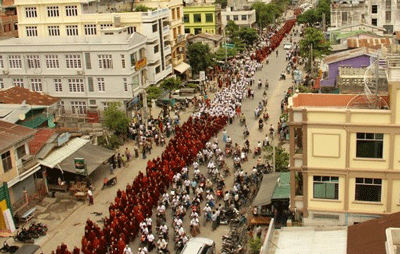Buddhist monks in Burma protested at the weekend to back President Thein Sein's suggestion to deport the minority Muslim Rohingyas, but organizers called off further demonstrations over crowd control measures.
The protest march on Sunday in Mandalay attracted a large number of monks wearing their traditional deep red robes joined by an equally large group of city residents. Some reports suggested that the crowd swelled to several thousands, triggering security concerns by the authorities.
The monks supported Thein Sein's call to the U.N. refugee agency UNHCR to deport hundreds of thousands of Rohingyas living in Burma even though they have lived in the country for generations.
The call, which was swiftly rejected by the UNHCR, came after deadly violence in Burma's western Rakhine state in June between ethnic Rakhine Buddhists and the Rohingyas that left scores of people dead and tens of thousands displaced.
Burma does not recognize the Rohingya as one of its ethnic groups, considering them illegal immigrants from Bangladesh. The U.N. says some 800,000 Rohingyas live in Burma and that the group is one of the world’s most persecuted minorities.
Deep resentment
A broad view of the street protests in Mandalay, Sept. 2, 2012
AFP
The protests by the monks on Sunday is the latest indication of deep resentment by Burmese against the Rohingya minority.
"This is to show solidarity and support of the Mandalay clergy and the city's population for President U [honorific] Thein Sein regarding his stand on the Rakhine state crisis," Wirathu, who led the protest by the Mandalay monks, told RFA's Burmese service.
He said they decided to call off the protests, which were scheduled to continue until Tuesday, after discussions with the authorities.
"The main point [is that] the authorities are worried about [the crowds of people joining the protesting monks.] They insist we’d have to control these monks and townspeople. They want us to stop crowds following us from the sidelines," he explained.
"We can only take responsibility for those within the ropes we hold. People outside the ropes should be their responsibility. And they said we must call it off if we can't control them."
Despite only 100 residents of Mandalay officially allowed to protest, the city’s security forces stood by and allowed thousands to march without hindrance, the Irrawaddy online journal reported.
It was the biggest protest since the monk-led Saffron Revolution in 2007, which was brutally crushed by the country's then military leaders.
Wirathu told Agence France-Presse that as many as 5,000 monks had joined the procession, with another several thousand people taking to the streets to watch.
The protest was to "let the world know that Rohingya are not among Myanmar's [Burma's] ethnic groups at all," he said.
One banner held by the protesters read, "Protect Mother Myanmar by supporting the President." Others criticized U.N. human rights envoy Tomas Ojea Quintana, who had been accused of bias by several Burmese political parties in his reporting on the conflict between the Rakhines and Rohingyas.
Quintana had visited the troubled Rakhine state last month and called for an “independent and credible investigation” into the conflict.
Thein Sein has set up a 25-member commission to investigate the ethnic violence.
International rights groups claim the government did little to stop the violence initially and then turned its security forces on the Rohingya with targeted killings, rapes, mass arrests, and torture.
Reported by RFA's Burmese service. Translated by Khin Maung Nyane. Written in English by Parameswaran Ponnudurai.





